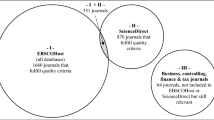Abstract
This paper clarifies some of the conflicting arguments about the value relevance of deferred taxes. We address two questions. First, does accounting aggregation hold, or in other words, are deferred tax expense and liability balances valued the same as operating earnings and asset balances, respectively? Second, what accounting method for deferred taxes preserves classical accounting relations, or should deferred taxes be recorded as equity, as debt, or as some combination of these categories? We answer these questions using a model of depreciable assets and cashflow dynamics identical to Feltham and Ohlson (1996). We find that aggregation does not hold; rather deferred taxes are valued less than earnings and book value. Deferred taxes add value because they represent the deferral of tax payments, so their value is the net present value of the tax benefits. We interpret this result to mean that the timing of the reversal of temporary differences does matter, consistent with recent empirical work. Our analysis shows that the deferred tax liability, as currently recorded in accordance with US GAAP, overstates the liability. Also, we find that the classical accounting relations hold only when deferred taxes are adjusted to their net present value. Further, the extent of this adjustment depends on whether or not the tax benefits are capitalized into the cost of the operating asset. If the benefits are reflected in the asset's cost, deferred taxes should be adjusted down based on the ratio of the discount rate over the sum of the tax depreciation and discount rates. Otherwise, the entire balance should be treated as equity.
Similar content being viewed by others
References
Accounting Principles Board (APB). (1967). Accounting for Income Taxes. Opinion (No. 11) New York, NY: American Institute of Certified Public Accountants.
Amir, E., M. T. Kirschenheiter and K. L. Willard (1997). “The Valuation of Deferred Taxes.” Contemporary Accounting Research 14 (Winter), 597-622.
Bierman, Harold Jr. (1961). “Depreciable Assets—Timing of Expense Recognition.” The Accounting Review XXXVI No. 4 (October), 613-618.
Davidson, S. (1958). “Accelerated Depreciation and the Allocation of Income Taxes.” The Accounting Review XXXIII No. 2 (April), 173-180.
Drake, D. F. (1962). “The Service Potential Concept and Inter-Period Tax Allocation.” The Accounting Review XXXVII No. 4 (October), 677-684.
Dybvig, P. H. and S. A. Ross (1986). “Tax Clienteles and Asset Pricing.”Journal of Finance XLI (July), 751-763.
Financial Accounting Standards Board (FASB). (1992). Statement of Accounting Standards No. 109: Accounting for Income Taxes.
Feltham, G. A. and J. A. Ohlson (1996). “Uncertainty Resolution and the Theory of Depreciation Measurement.” Journal of Accounting Research 34 (Autumn), 209-234.
Goolsbee, A. (1998). “Investment Tax Incentives, Prices and the Supply of Capital Goods.” Quarterly Journal of Economics CXIII (February) 1, 121-148.
Goulder, L.H. and L. H. Summers (1989). “Tax Policy, Asset Prices and Growth:AGeneral Equilibrium Analysis.” Journal of Public Economics 38 (April) 3, 265-296.
Guenther, D. A. and R. C. Sansing (2000). “Valuation of the Firm in the Presence of Temporary Book-Tax Differences: The Role of Deferred Tax Assets and Liabilities.” The Accounting Review 75 (January) 1, 1-12.
Hackel, K. S. and J. Livnat (1992). Cash Flow and Security Analysis. Business One Homewood, Ill.
Lundholm, R. (2000). “Discussion of 'The Aggregation and Valuation of Deferred Taxes.” Review of Accounting Studies (current issue).
Nurnberg, H. (1971). Cash Movements Analysis of the Accounting For Corporate Income Taxes MSU Business Studies, Division of Research, Graduate School of Business Administration, Board of Trustees of Michigan State University, East Lansing, MI.
Ohlson, J. A. (1995). “Earnings, Book Values and Dividends in Security Valuation.” Contemporary Accounting Research 11 (Spring), 661-688.
Ohlson, J. A. and S. Penman. (1992). “Disaggregated Accounting Data as Explanatory Variables for Returns.” Journal of Accounting, Auditing and Finance 7(4), 553-573.
Sansing, R. (1998). “Valuing the Deferred Tax Liability.” Journal of Accounting Research 36 (Autumn) 2, 357-364.
Stiglitz, J. E. (1976).“The Corporation Tax.” Journal of Public Economics 5, 303-311.
White, G. I., A. C. Sondhi, and D. Fried (1994). The Analysis and Use of Financial Statements. New York: John Wiley and Sons.
Author information
Authors and Affiliations
Rights and permissions
About this article
Cite this article
Amir, E., Kirschenheiter, M. & Willard, K. The Aggregation and Valuation of Deferred Taxes. Review of Accounting Studies 6, 275–297 (2001). https://doi.org/10.1023/A:1011619010143
Issue Date:
DOI: https://doi.org/10.1023/A:1011619010143




